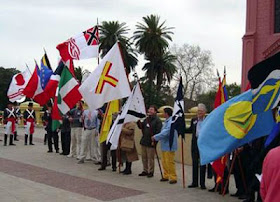The 25th International Congress of Vexillology (ICV) will be held in Rotterdam, Netherlands, from August 4 to 10, 2013 simultaneously the 23rd session of the General Assembly of the Fédération Internationale des Associations Vexillologiques (FIAV), amid flag-related tours, seminars, and meetings among various vexillologists on specific topics. The Netherlands Vexillological Association, the Netherlands Flag Museum Foundation and the Rotterdam Flag Parade Foundation, the three Dutch partners joined forces to organize the 25th ICV. http://www.nfc2013.com/
Flag parade of FIAV-members (photo: Francisco Gregoric)
The International Federation of
Vexillological Associations (FIAV) is the umbrella organization of flag-studies associations
worldwide. Its members (on six
continents) pursue Vexillology - the study of flags of all kinds, their history
and their symbolism. FIAV's aim is
to promote vexillology as science, to
coordinate the activities of its members, to facilitate the exchange of
information, and to bring the vexillologists
of the different countries closer together. Today FIAV is an international community of over one thousand
specialists and friends of flags of all kinds, organized in national or
regional organizations. Since 1965, the vexillologists of the world meet every
two years in an International Congress, hosted by one of its member
associations. Since 1969, FIAV has
sponsored the biennial International
Congresses of Vexillology (ICV).
Previous Congresses have been held in Muiderberg (1965), Zürich and Ruschlikon
(1967), Boston (1969), Turin (1971), London (1973), Ijsselmeer (1975),
Washington D.C. (1977), Vienna (1979), Ottawa (1981), Oxford (1983), Madrid
(1985),San francisco (1987), Melbourne (1989), Barcelona (1991), Zürich (1993),
Warsaw (1995), Cape Town (1997),Victoria
(1999), York (2001), Stockholm (2003), Buenos Aires (2005), Berlin (2007), Yokohama
(2009), and Alexandria (2011).
The FIAV Flag is rectangular in 2:3 proportions.
On royal blue field appear two horizontally positioned halyards, reaching from
the hoist to the fly, which form in the centre of the flag the "vexillological
knot".
The
halyards symbolize Vexillology, the science of flags. The blue field of the flag
and the two halyards recall navigation, which made flags known all over the
world. The knot is symbol of friendship between vexillologists of all nations. The two loops of the knot represent
the close ties between the two hemispheres of the world. The two halyards cross
the flag from one end to the other--and beyond--thus marking the almost
unending field of vexillological research.
The four ends of the halyards and the two loops together make "6", as there are six continents, expressing FIAV's international character.
The four ends of the halyards and the two loops together make "6", as there are six continents, expressing FIAV's international character.
Klaes
Sierksma (Netherlands) originated the idea to symbolize FIAV with a knot
formed by halyards on its flag. In 1967 a committee of the 2nd International
Congress of Vexillology make slight
changes to Sierksma's proposal and asked Paul
Krog to make the final design.
Woman with vexillum
(circa 100 BCE)
Dr. Whitney Smith (b. 1940) is recognized world over as the Father of Vexillologists. The term Vexillology, which Smith
originated in his 1958 article Flags of the Arab World, refers to the scholarly analysis of all
aspects of flags. In his own words “When I went to the New York Public
Library as a teenager (18), I discovered that flags were lumped in with
heraldry and similar topics. I felt that the study deserved a name of its
own, which I coined: vexillology—vexillum being the Latin
word for flag and ology the Greek word for the study of”.
In 1961, Boston University student Whitney Smith, 21 and New
York City high school teacher Gerhard
Grahl , 26 set out the initial issue of the world’s first journal devoted
entirely to flags. Publication of No. 1 of The Flag Bulletin, in October
1961 can be considered the “birthday of vexillology”
because it signaled the first
international, public, scholarly, and ongoing commitment to the study of flags.
(The Flag Bulletin, No 118, Vol. XXXV, No 5, p.163). The following year, Smith
established the Flag Research Center
in USA.
Dr.
Smith worked with Klaes Sierksma to
organize the First International
Congress of Vexillology at Muiderberg, Netherlands in 1965. Thereafter they
joined Louis Mühlemann in founding the Fédération internationale des
associations vexillologiques or The
International Federation of Vexillological Associations, known by its
acronym—FIAV, which was formally
inaugurated in 1969.
Smith
was also responsible for founding the North
American Vexillological Association (NAVA) in 1967. NAVA's Whitney Smith Award for an outstanding
contribution to North American vexillology
is named in Smith's honor.
Dr.
W. Smith has written several books on the subject of flags, notably Flags
Through the Ages and Across the World, The Flag Book of the United
States, and Flag Lore of all Nations.
Dr.W.
Smith was the designer of the national Flag
of Guyana and has served as a vexillographer (flag designer) to a number of
governments and organizations.
My first contact with Dr Whitney Smith, Director of the Flag
Research Center, Winchester, Mass.
Prof. Michel Lupant took this photo of Dr. Whitney
Smith on 24 July 2011 in his home in Winchester (The Flag Research Centre). Dr. Smith has in his hand the Vexillum he had manufactured himself
when he was young and began his flags collection.

Prof.
Michel R. Lupant: President
of the International Federation of Vexillological Association (FIAV), and the
founder of the Belgian European Flags Studies Centre.







